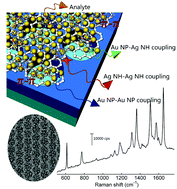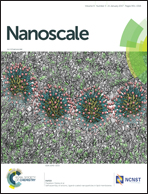Toward highly sensitive surface-enhanced Raman scattering: the design of a 3D hybrid system with monolayer graphene sandwiched between silver nanohole arrays and gold nanoparticles†
Abstract
We report a novel graphene–metal hybrid system by introducing monolayer graphene between gold nanoparticles (Au NPs) and silver nanohole (Ag NH) arrays. The design incorporates three key advantages to promote the surface-enhanced Raman scattering (SERS) sensing capacity: (i) making full use of the single-atomic feature of graphene for generating uniform sub-nanometer spaces; (ii) maintaining the bottom layer of Ag nanoarrays with an ordered manner for facilitating the transfer of graphene films and assembly of the top layer of Au NPs; (iii) integrating the advantages of the strong plasmonic effect of Ag, the chemical stability of Au, as well as the mechanical flexibility and biological compatibility of graphene. In this configuration, the plasmonic properties can be fine-tuned by separately optimizing the horizontal or vertical gaps between the metal NPs. Exactly, sub-20 nm spaces between the horizontally patterned Ag tips constructed by adjacent Ag NHs, and sub-nanometer scale graphene gaps between the vertically distributed Au NP–Ag NH have been achieved. Finite element numerical simulations demonstrate that the multi-dimensional plasmonic couplings (including the Au NP–Au NP, Au NP–Ag NH and Ag NH–Ag NH couplings) promote for the hybrid platform an electric field enhancement up to 137 times. Impressively, the as-prepared 3D Au NP–graphene–Ag NH array hybrid structure manifests ultrahigh SERS sensitivity with a detection limit of 10−13 M for R6G molecules, as well as good reproducibility and stability. This work represents a step towards high-performance SERS substrate fabrication, and opens up a new route for graphene–plasmonic hybrids in SERS applications.


 Please wait while we load your content...
Please wait while we load your content...